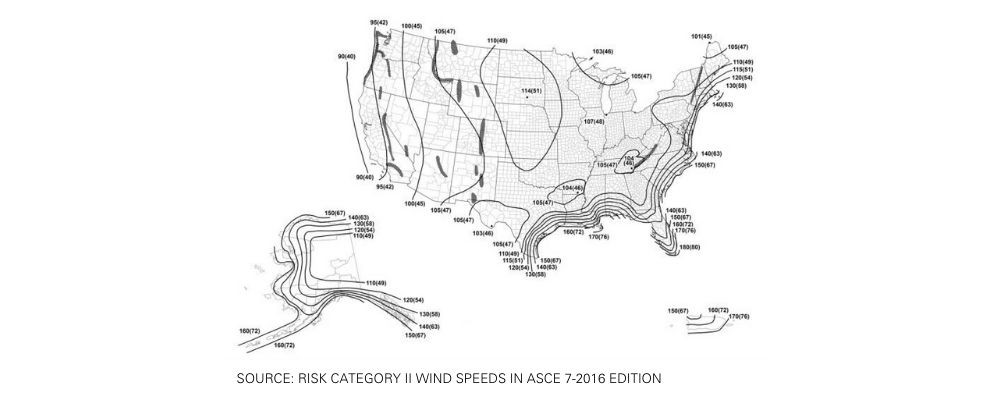The impact of the adoption and enforcement of IECC 2015, IBC 2018; ASCE 7-16 building codes and what contractors need to know to be prepared.
There have been many changes to the International Energy Conservation Code (IECC), the International Building Code (IBC) and the American Society of Civil Engineers (ASCE 7) standard “Minimum Design Loads and Associated Criteria for Buildings and Other Structures” with regards to roof system design and installation. As more States, Counties and local municipalities adopt these new codes, it is important that contractors know how they will be impacted. The new codes will have a direct effect on job costs and project installation timelines; and staying abreast of these changes are critical to contractors’ businesses. Understanding all of the nuances of these code changes is not an easy task.
There is much confusion on the changes that have been adopted by each code body and implemented at the state, city and municipality levels within the design community, as well as within the contractor community. This document will highlight the issues that are causing the confusion specifically related to R-values and roof fastening patterns. It will help clarify these modifications, as well as provide resources to help navigate the changing landscape.
IECC 2015
From the time the 2009 edition of the IECC was published until the most current published 2015 version, the IECC building code has increased R-value requirements year over year by 30%, on average. More significant than the code changes, is the fact the climate zone map itself changed. If the roof systems that you are currently installing do not take into account the most current R-value requirements, even if code officials are not currently enforcing the laws in your area, you could be held liable down the road.
Roofing materials manufactures are good sources for guidelines into codes, but it is ultimately the building code official that ensures that the roof is compliant. It is, therefore, important to work closely with your building code officials to ensure your roof systems are in compliance. Why is it so important? If for any reason the building is found to not be up to code, not only does that expose you to having to bring it up to code, but you may be liable for any ‘lost’ energy savings that could have been realized between the time of installation and the time of the documented infraction.

Current Climate Zone Map

According to the U.S. Department of Energy, roof R-value requirements are based on assembly type and insulation placement:
- Insulation entirely above deck
- Metal buildings
- Attic and other

The code states that continuous tapered insulation boards should be staggered when installed. Skylight curbs are to be insulated to the level of roofs with insulation entirely above deck or R-5, whichever is less (exception: unit skylight curbs included as a component of a skylight listed and labeled per NRC 100).
There are roof assembly exceptions outlined in Section C402.2.2 that are as follows:
- Tapered insulation is used with insulation entirely above deck, the R-value where the insulation thickness varies 1” or less from the minimum thickness of tapered insulation must comply with the R-value specified in Table C402.1.3
- Two layers of insulation aren’t required where insulation tapers to the roof deck (e.g., at roof drains)(1)
The roof R-Value is calculated by the insulation completely above deck where the insulation is considered continuous. Note, the insulation thickness can vary ≤ 1” and area weighted U-factor meets the requirements of Table C402.1.3. Insulation placed on a ceiling with removable ceiling tiles will not count for code compliance and is not considered part of the minimum thermal resistance of the roof insulation(2).
IECC is most commonly adopted at the State level. There are some instances, however, where local jurisdictions have adopted IECC 2015 before the State has adopted those changes, or in States that don’t have their own energy conservation code. Do your due diligence by periodically checking for code updates in your local area. The good news is that both the 2018 and 2021 proposed versions of the code do not reflect any more changes related to roof assemblies.
IBC 2018; ACSE 7-16
The IBC 2018 incorporates the ACSE 7-16 edition and features fundamental changes to items that have been in place since the late 1970s. The drastic differences include the methodology in determining roof perimeter and corner wind pressure, and the change in definition of the fastening area on the roof on buildings that are less than 60 feet high(3).
The newer roof pressure coefficients have changed significantly in much of the country, so it is critical to work closely with your designers and local building code officials, to ensure that the correct values are used in the calculations so that your roofs are in compliance. The new Ke factor adjusts the velocity pressure to account for the reduced mass density of air as elevation above sea level increases (see Table). This factor provides a convenient way to adjust the velocity pressure in the wind pressure calculations for those buildings that are in areas with reduced mass density of air. The adjustment can be significant for locations that are located at higher elevations.
Below is one of four maps that are used in determining building category.

In previous editions of these codes, three roof zones existed: 1 (field), 2 (perimeter) and 3 (corner). With the ASCE 7-16 edition, a fourth zone has been added, 1’, which also is a field zone. However, this zone may not apply to smaller roofs, thus not applying to many buildings. Reference NRCA’s roof wind calculator website to determine the appropriate zone for the building(4). The tests conducted for this edition determined that zoning on low-slope roof structures was heavily dependent on the building height, and much less dependent on the size of the building. Results of these tests showed that previously approved perimeter and corner areas were now too small for high roof pressures(5). The areas for zones 1-3 have increased, as shown in the below examples(6).

As a result, costs associated with code compliance can be prohibitive, with an average increase of materials and labor to be 25-30%. If you are bidding against a competitor that isn’t compliant, be sure to educate your customer.
(3) U.S. Department of Energy https://www.energycodes.gov/sites/default/files/becu/2018_IECC_commercial_requirements_envelope.pdf
(4) NRCA’s resource, www.roofwinddesigner.com
(6) Example of ASCE 7-16 low slope roof component and cladding zoning.
So, where do you go from here?
Stay informed. There are many resources to help you navigate the requirements.
Wind design data; wind speed, risk category and design wind pressures to be used for components and cladding materials shall be shown in the construction documents as stated in Chapter 16 of the IBC.
Partner with reputable manufacturers. Make sure your roofing materials manufacturer is on top of the changes and ensuring they offer system solutions that meet or exceed code requirements.
Talk to your building code officials. Work with them to ensure you’re in compliance and be on the lookout for those that are not.
Available Resources:
The National Roofing Contractors Association (NRCA) lists and explains all the building codes and standards on their website here. NRCA also lists Energy Codes by State on their website here. For a more comprehensive list of State energy codes, visit https://www.energycodes.gov/adoption/states.
If you are looking for a way to help construct roof assemblies that evaluate thermal performance and estimated energy cost, visit NRCA’s EnergyWise Roof Calculator here.
An online version of the ASCE 7-16 publication is available at www.asce.org/asce-7/. The online version shows changes between the 2010 and 2016 editions, and it provides a side-by-side demonstration of any provisions with explanatory information.
To help determine roof systems’ design wind loads for commonly encountered building types that are subject to building code compliance, visit NRCA’s resource, www.roofwinddesigner.com. Basic wind speed can be found by entering a building’s address in the Applied Technology Council’s (ATC’s) website. The basic wind speed also can be found using the ASCE Hazard tool here.
Take the time to do your research, stay informed and educate your installers. Doing so will not only ensure longevity for your business, it will also continue to raise the bar in roof system installation and the industry as a whole.
Johns Manville (JM) is committed to providing commercial roof systems that deliver solutions for meeting the building code requirements. Investing in testing and approvals of JM products and systems is an ongoing venture to ensure JM customers have the best system options available to them. To stay up to date on JM approvals, check out our Codes Corner here: https://www.jmroofing.news/codes-corner
Resources
http://docserver.nrca.net/technical/10259.pdf
https://www.energycodes.gov/sites/default/files/becu/2018_IECC_commercial_requirements_envelope.pdf
https://crsmca.org/images/downloads/Publications/crsmca_janfeb18_vf_web.pdf
The information contained in this article is provided by Johns Manville and is provided for educational and informational purposes only, and should not be construed as legal, engineering or design advice or as an offer to perform such services. The content of this article contains general information and may not reflect current developments or information. The information is not guaranteed to be complete or current. Johns Manville makes no warranty, expressed or implied, about the accuracy or reliability of the information in this article or at any other website to which it is linked.

